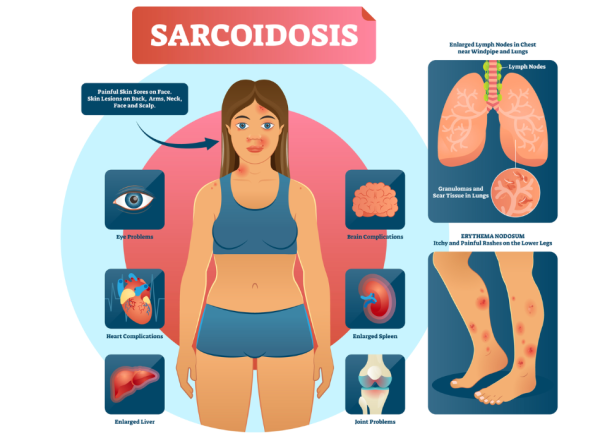Wishing everyone happy holidays and a joyful New Year from the Healthify team. Don't forget to Slip, Slop, Slap and Wrap!
Sarcoidosis | Mate pauku
Key points about sarcoidosis
- Sarcoidosis is a rare condition that mainly affects people's lungs, although sometimes it can affect other parts of the body.
- Not everyone has symptoms, but they can include a dry cough, chest pain or discomfort, tiredness, unintended weight loss and painful red lumps on the front of your legs.
- The exact cause of sarcoidosis is not known but it seems to run in families. It may be that an infection triggers it in people whose genes put them at risk of getting it.
- It can affect people of any age, but occurs mostly in people aged between 25 and 45 years.
- It generally only lasts a few years.
- The content on this page is based on information from HealthInfo(external link).

Sarcoidosis is a rare condition that mainly affects people's lungs, leading to breathlessness, a cough, and chest pain or discomfort. It is caused by small pockets of inflammation called granulomas. It can also affect other parts of your body.
Sarcoidosis usually happens to people between 25 and 45 years of age.
The signs and symptoms of sarcoidosis vary depending on which organs are affected. Many people don't have any symptoms, others may have one or more of the following:
- A persistent cough.
- Chest pain or discomfort.
- Tiredness.
- Unintentional weight loss.
- Fever.
- Painful red lumps (called erythema nodosum) on the front of the legs.
- Tender, swollen glands.
- Uveitis (eye inflammation).
- Headache, numbness and weakness.
- Abnormal heart rhythm or breathlessness from heart failure.
- Sore joints.
- Kidney stones.
Most people have acute sarcoidosis, which only lasts a few years. But there's a rarer form known as chronic sarcoidosis that can need long-term treatment.

Image credit: Depositphotos
If you think you may have sarcoidosis, speak to your healthcare provider who can organise some tests for you. These may include a complete blood count, and a chest X-ray. They can also include spirometry, which is a test to measure how well your lungs are working.
You may need to see a hospital specialist for further tests, such as a CT scan or a biopsy. A biopsy is where a small bit of tissue is taken so it can be tested in a laboratory.
As sarcoidosis often goes away on its own within 1 to 3 years, many people with mild disease won't need any treatment. Your healthcare provider will monitor you over this time.
If you have more severe symptoms, you'll usually be treated with oral steroids (prednisone). Sometimes you'll also need medicines that suppress your immune system (immunosuppressants).
Prior to being diagnosed with sarcoidosis, Romaine had never heard of the disease. Her symptoms started with a dry cough, which became far worse about a year later. Unable to speak a sentence without coughing, Romaine began taking medicine to treat her sarcoidosis. Also, she began to focus on following a healthy lifestyle, including eating well and being physically active. By following her treatment plan and making lifestyle changes, Romaine is able to live a full, active life.
(National Heart, Lung and Blood Institute, US, 2011)
Reference
- Sarcoidosis(external link) Health New Zealand | Te Whatu Ora, NZ
- Sarcoidosis(external link) NHS, UK, 2022
Credits: Content used with permission from HealthInfo Canterbury as part of a National Content Hub Collaborative
Reviewed by: Healthify editorial team.
Last reviewed:
Page last updated:





